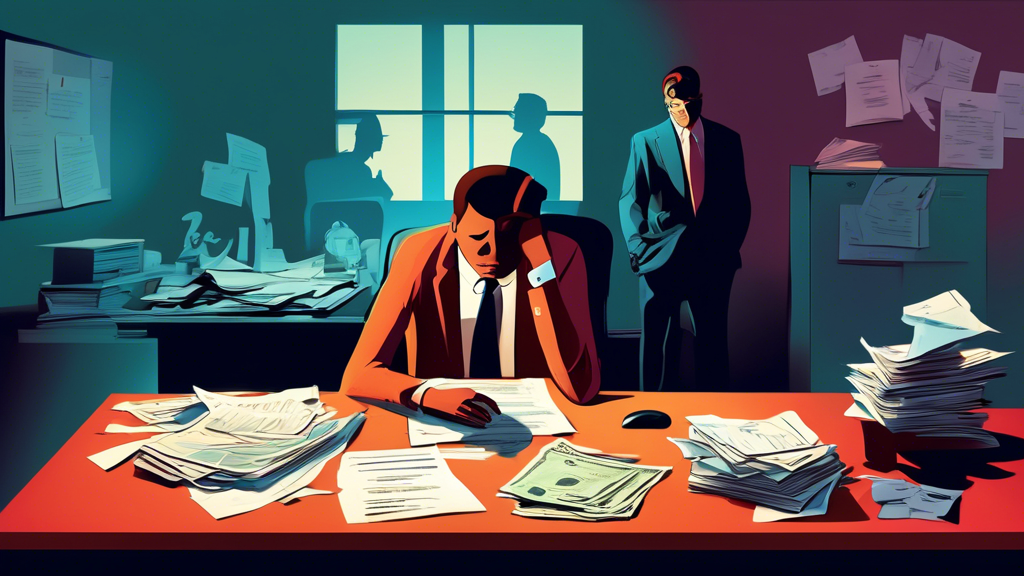Yes, the Canada Revenue Agency (CRA) can indeed garnish wages, but what does this mean for you, and how does it work? Understanding CRA’s authority and the wage garnishment process is crucial for every taxpayer. The CRA holds significant legal power to ensure that taxes owed are collected, and wage garnishment is one of their most assertive methods. This article will provide you with a clear overview of the CRA’s legal framework and guide you through the step-by-step process they follow to initiate wage garnishment.
If you find yourself facing wage garnishment by the CRA, it is essential to be aware of the potential financial and legal consequences. Wage garnishment can disrupt your financial stability and escalate your debt issues. Therefore, knowing the necessary actions and strategies to mitigate or even prevent wage garnishment is vital. Throughout this article, we will explore the implications of wage garnishment and offer practical steps you can take to manage and resolve issues with the CRA effectively. By the end of this article, you will be equipped with the knowledge to navigate the complexities of wage garnishment and take control of your financial situation.
Understanding CRA’s Authority and Wage Garnishment Process
Overview of CRA’s Legal Authority to Garnish Wages
The Canada Revenue Agency (CRA) holds significant power when it comes to collecting unpaid taxes and related debts. The authority granted to the CRA allows them to employ various collection methods, one of which is wage garnishment. But, can CRA garnish wages? The short answer is yes.
Under Canadian law, the CRA is empowered to garnish wages without needing to obtain a court order, a privilege not granted to many other creditors. This authority stems from the Income Tax Act and Excise Tax Act, which provide the CRA with the robust legal framework required to enforce debt collection efficiently. When an individual owes taxes or has outstanding debts related to federal programs, the CRA can directly approach the individual’s employer and instruct them to deduct a portion of the debtor’s salary.
It’s important to note that the CRA will typically resort to wage garnishment only after it has attempted other less invasive collection methods. These may include sending demand letters or proposing payment plans. However, if the taxpayer remains non-compliant or unresponsive, wage garnishment becomes a necessary tool in the CRA’s collection arsenal.
Step-by-Step Explanation of How CRA Initiates Wage Garnishment
Knowing that the CRA can garnish wages is one thing, but understanding the step-by-step process they follow can provide clarity and potentially help affected individuals prepare and act accordingly.
Step 1: Identifying Outstanding Debt
The first step in the wage garnishment process involves the CRA identifying that there are outstanding debts. This can include unpaid taxes, overdue child support payments, or non-compliance with repayment agreements for government-assisted programs. The CRA uses sophisticated systems to track and verify these debts.
Step 2: Issuing a Requirement to Pay (RTP)
Once the CRA has identified an outstanding debt, they may issue a Requirement to Pay (RTP) to the debtor’s employer. The RTP is a formal document that instructs the employer to withhold a specified portion of the debtor’s wage and remit it directly to the CRA. Unlike private lenders who must obtain a court judgment, the CRA can issue an RTP without additional legal proceedings.
Step 3: Notification to the Debtor
While the CRA is not obligated to inform the debtor in advance of wage garnishment, they often do. Typically, the agency will have previously sent multiple notices and attempts to resolve the debt before issuing an RTP. However, some debtors might find out about the garnishment only after their employer has received the RTP.
Step 4: Employer Compliance
Upon receiving the RTP, the employer is legally bound to comply with the CRA’s instructions. Failure to do so can result in the employer being held liable for the specified amount. Employers must deduct the specified amount from the debtor’s wages and remit it to the CRA within the stipulated deadlines until the debt is fully paid off.
Step 5: Monitoring and Adjusting the Garnishment
Throughout the garnishment period, the CRA monitors the payments received. If additional debts are identified or if the debtor’s financial situation changes significantly, the CRA may adjust the garnishment amount. Debtors have the right to request a reassessment or propose an alternative repayment plan if they find the garnishment amount intolerable.
Step 6: Terminating the Garnishment
Wage garnishment usually continues until the debt is fully liquidated. However, garnishment can also end if the debtor negotiates a new repayment plan or if circumstances such as job loss make it impossible to continue the garnishment process. The CRA will issue a notice to the employer once the garnishment is to cease.
Key Takeaway
Understanding that the CRA can garnish wages and grasping the process they follow to enact it are essential pieces of knowledge for any taxpayer. With significant legal powers and a straightforward procedural framework, the CRA ensures that it can effectively collect unpaid debts through wage garnishment when other measures fail.
In sum, if you’re wondering can CRA garnish wages, the answer, backed by legal provisions and procedural steps, is unequivocally yes. Knowing how and why this can happen enables individuals to take more informed actions to either prevent the garnishment or mitigate its impact, and ultimately stay in control of their financial health.
See if you qualify for debt relief

Implications and Steps to Take When Facing Wage Garnishment by CRA
Potential Financial and Legal Consequences of Wage Garnishment
When the Canada Revenue Agency (CRA) exercises its authority to garnish wages, it can lead to a series of financial and legal repercussions that can significantly impact your livelihood and peace of mind.
Firstly, wage garnishment by the CRA results in an immediate reduction in your disposable income. The amount garnished is redirected to the CRA to settle outstanding tax debts, which means you will see a noticeably smaller paycheck. This reduction can strain your ability to manage everyday living expenses such as rent, utilities, food, and other essentials.
Secondly, the garnishment could affect your credit score. While the act of garnishment itself might not directly impact your credit report, the circumstances leading to garnishment, such as unpaid taxes or defaulted payments, may already have harmed your credit rating. Moreover, the sheer financial pressure from reduced income might cause you to miss other payments, further damaging your credit profile.
Thirdly, wage garnishment can lead to increased scrutiny from other creditors. Once they become aware of the garnishment, creditors might perceive you as a higher risk, potentially leading to more stringent credit terms or even denial of loans and credit access.
From a legal standpoint, having wages garnished by the CRA signifies that you have unresolved tax issues that have escalated to a severe level. This could involve additional penalties and interest that accrue on your unpaid taxes, exacerbating the initial tax debt. In some cases, it might also prompt other legal actions from the CRA, such as liens on property or seizure of other financial assets.
Essential Actions and Strategies to Mitigate or Prevent CRA Wage Garnishment
Facing a wage garnishment scenario with the CRA can be distressing, but there are proactive measures you can take to mitigate or even prevent such actions. Here are key steps and strategies to consider:
1. Communicate with the CRA Promptly
Upon receiving any indication that the CRA may garnish your wages, it is crucial to contact them immediately. Ignoring notices or delaying communication can worsen the situation. Engaging with the CRA shows your willingness to resolve the tax debt and may lead to more favorable arrangements, such as a payment plan.
2. Negotiate a Payment Plan
If you cannot pay the full amount owed, negotiating a payment plan with the CRA is a viable option. Payment plans allow you to pay off your debt in manageable installments over a specified period. It’s essential to be realistic and transparent about your financial situation to ensure the proposed plan is feasible.
3. File Any Outstanding Tax Returns
Unfiled tax returns can be a primary reason for CRA’s decision to garnish wages. If you have any outstanding filings, get them submitted as soon as possible. Not only does this demonstrate your intent to comply with tax regulations, but it also helps clarify the exact amount owed, potentially reducing the estimated debt initially targeted for garnishment.
4. Seek Professional Tax Advice
Tax issues can be complex and daunting to navigate alone. Hiring a professional, such as a tax attorney or an accountant, can provide invaluable assistance. These experts can negotiate with the CRA on your behalf, help organize your financial documents, and provide strategic advice tailored to your unique situation.
5. Consider Financial Hardship Provisions
If wage garnishment is causing significant financial hardship, you can appeal to the CRA’s sense of reason through a Taxpayer Relief Request. This request outlines the financial distress the garnishment is causing and asks for leniency or alternate arrangements. Documentation of your financial situation will be required to support your case.
6. Explore Alternatives to Borrowing
In some scenarios, securing a loan to pay off the tax debt might seem like a logical solution. However, this option should be approached with caution, as it can lead to further financial strain if not managed correctly. Evaluate your ability to repay the loan and consider consulting a financial advisor to determine if this route is truly beneficial.
7. Stay Informed and Proactive
Knowledge is power when dealing with tax obligations. Stay informed about your rights and obligations as a taxpayer. Regularly reviewing your tax situation, staying current with filings and payments, and being aware of any changes in tax laws will help you avoid future garnishment situations.
By understanding the severe implications of wage garnishment and taking quick, informed actions, you can better navigate the challenges posed by the CRA. Every step towards resolving your tax debt is a step towards regaining financial stability and peace of mind.
Remember, the question isn’t just can CRA garnish wages? but rather “how can you prevent or mitigate the garnishment effectively?” Through vigilance, proactive measures, and professional guidance, you can manage your tax liabilities more effectively, ensuring minimal disruption to your financial health.
In conclusion, the Canada Revenue Agency (CRA) indeed holds the legal authority to garnish wages as a means of enforcing tax collection. Understanding this authority and the process by which wage garnishment is initiated is crucial for any individual or business facing potential action by the CRA. The CRA follows a structured and transparent procedure to garnish wages, ensuring compliance with Canadian financial laws while safeguarding taxpayer rights.
If confronted with the possibility of wage garnishment by the CRA, it is essential to recognize the serious financial and legal ramifications that may follow. Promptly taking proactive steps, such as seeking professional tax advice and negotiating payment arrangements, can significantly mitigate or even prevent the initiation of wage garnishment. By staying informed and addressing issues proactively, taxpayers can better manage their obligations and avoid the far-reaching consequences of enforced tax collection measures.
See if you qualify for debt relief
